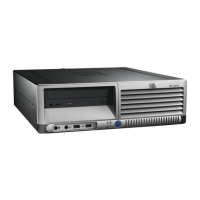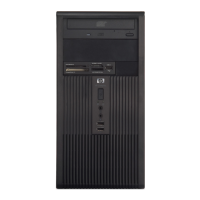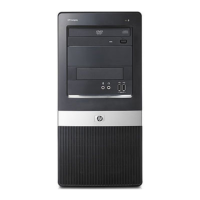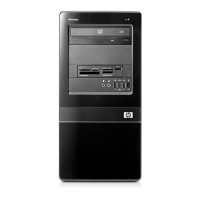Configuration Options Table
Radeon Xpress 300 External PCIe Graphics Card ATI SurroundView (F10 Setup) PCI Graphics Card
VGA + DVI Not Installed Not Applicable
Disabled Non-ATI graphics card
1
Not Applicable
Disabled
2
ATI graphics card Disabled
VGA + DVI
2
ATI graphics card Enabled
A PCI Card can be
installed in any
configuration. This is a
standard multi-display
feature supported by the
Microsoft Operating
System.
Notes:
1. When using a non-ATI PCI Express (PCIe) graphics card, SurroundView is not supported. The integrated graphics processor (IGP) is
automatically disabled, and the system memory allocated to the IGP is freed for other use.
2. When installing an ATI PCIe graphics card, SurroundView is disabled by default. Enabling SurroundView in the BIOS (F10 Setup) enables the
integrated UMA graphics controller, which in turn makes available up to two additional graphics outputs. When enabling the integrated UMA
graphics controller, system memory will be reallocated.
• The amount of memory allocated to internal graphics is determined in the BIOS (F10 Setup) setting
Advanced/Device Options/Integrated Graphics Memory Size. The default value “Automatic”
means that the Graphics memory is 32MB for a 256MB system, 64MB for a 512MB system, or
128MB for systems with more than 512MB installed. Alternatively, the user can specify the memory
size to use from 32MB, 64MB, 128MB, or 256MB.
• The option to disable the internal graphics will appear in the BIOS (F10 Setup) menu at
Advanced/Device Options/Integrated Video whenever a PCI graphics card is installed. Disabling
internal graphics frees up the allocated UMA graphics memory when a PCI graphics card is the
only adapter required.
• When a PCI graphics card is used in combination with the integrated graphics processor and/or a
PCIe graphics card, it cannot be set as primary. By default it is configured as a secondary
controller. If, instead, the PCI graphics card is the only enabled controller in the system, by
necessity it is the primary controller.
• Potentially, a non-ATI-branded PCIe graphics card could be installed, one that contains an ATI
chipset and uses ATI-based software drivers, but does not support SurroundView. This may be
caused by an older card and older driver source code. You may not be able to use SurroundView
with all PCIe card combinations. All ATI-branded PCIe cards support SurroundView. Consult
ATI
Technologies Inc. for a complete listing of ATI cards.
3
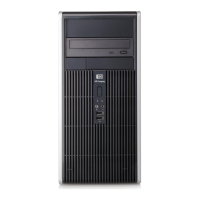
